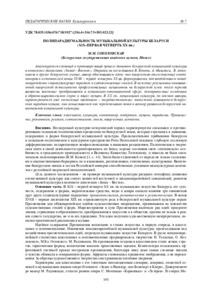Please use this identifier to cite or link to this item:
https://elib.psu.by/handle/123456789/20539Full metadata record
| DC Field | Value | Language |
|---|---|---|
| dc.contributor.author | Соколовская, М. М. | - |
| dc.date.accessioned | 2017-10-17T07:17:36Z | - |
| dc.date.available | 2017-10-17T07:17:36Z | - |
| dc.date.issued | 2017 | - |
| dc.identifier.citation | Вестник Полоцкого государственного университета. Серия E, Педагогические науки. - 2017. - № 7. - С. 193-198. | ru_RU |
| dc.identifier.uri | https://elib.psu.by/handle/123456789/20539 | - |
| dc.description | Poliparadigmality of the Belorussian Culture (XIX – First Quarter of the XXth Century) М. Sokolovskaya | ru_RU |
| dc.description.abstract | Анализируется сложный и противоречивый процесс динамики белорусской музыкальной культуры в контексте дихотомии «Запад – Восток». Опираясь на исследования В. Конона, А. Мальдиса, В. Антоневича и других белорусских ученых, автор обосновывает идею, что творчество отечественных композиторов и исполнителей конца ХVIII – первой четверти ХХ вв. формировалось под воздействием западноевропейских социокультурных парадигм и художественных стилей. В качестве результата инновационной творческой деятельности профессиональных музыкантов на белорусской земле этого периода выявлены заметные преобразования в музыкально-интонационной сфере, демократичные тенденции в образно-выразительном строе и языке музыки. В ХХ ст. музыкальная культура, по мнению автора, характеризуется уже системным свойством – эмерджентностью; постепенно усваивается белорусская народная музыка; она осмысливается как перспективная линия и вектор развития белорусской национальной музыкальной культуры.= We analyze the complex and contradictory process of deployment of the Belarusian musical culture in the context of the dichotomy of East - West. It is noted that the work of local composers and performers at the end XVIII - the first quarter of the twentieth century. created under the influence of Western European socio-cultural paradigms and styles. The result of creative work of professional musicians of Belarus were noticeable changes in the musical intonations, in the democratization of image-building and expressive language of music. In the twentieth century gradually begins to be assimilated by the creators of folk music, comprehended as a promising line and the vector of development of the Belarusian professional musical culture. | ru_RU |
| dc.language.iso | ru | ru_RU |
| dc.publisher | Полоцкий государственный университет | ru_RU |
| dc.relation.ispartof | Веснік Полацкага дзяржаўнага ўніверсітэта. Серыя E, Педагагічныя навукі | be_BE |
| dc.relation.ispartof | Herald of Polotsk State University. Series E, Pedagogical Sciences | en_EN |
| dc.relation.ispartof | Вестник Полоцкого государственного университета. Серия E, Педагогические науки | ru_RU |
| dc.relation.ispartofseries | Серия E, Педагогические науки;2017. - № 7 | - |
| dc.rights | open access | ru_RU |
| dc.subject | Классицизм | ru_RU |
| dc.subject | Культура | ru_RU |
| dc.subject | Композитор | ru_RU |
| dc.subject | Модернизм | ru_RU |
| dc.subject | Музыка | ru_RU |
| dc.subject | Парадигма | ru_RU |
| dc.subject | Classicism | ru_RU |
| dc.subject | Culture, | ru_RU |
| dc.subject | Composer | ru_RU |
| dc.subject | Modernism | ru_RU |
| dc.subject | The music | ru_RU |
| dc.subject | Paradigm | ru_RU |
| dc.title | Полипарадигмальность музыкальной культуры Беларуси (XIX – первая четверть ХХ вв.) | ru_RU |
| dc.type | Article | ru_RU |
| dc.identifier.udc | 78.035/.036(476)”18/192”:[316.4+316.73+303.023.22] | - |
| Appears in Collections: | 2017, № 7 | |
Files in This Item:
| File | Description | Size | Format | |
|---|---|---|---|---|
| 193-198.pdf | 186.05 kB | Adobe PDF |  View/Open |
Items in DSpace are protected by copyright, with all rights reserved, unless otherwise indicated.